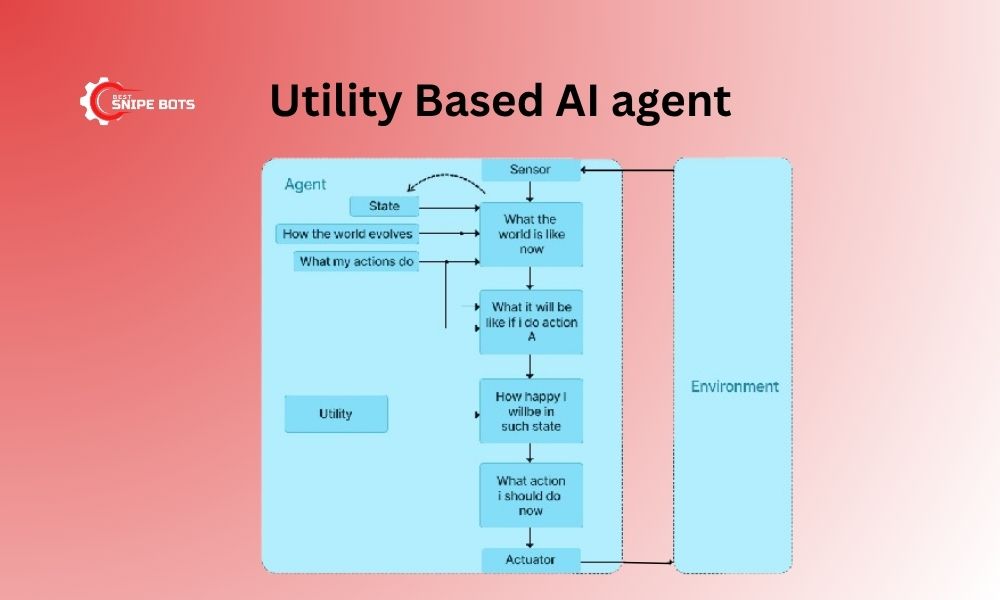A Utility Based AI agent is an intelligent agent model that makes decisions by analyzing and forecasting the future. Instead of merely reacting to the present, it uses sensors to perceive its environment, predicts the outcomes of each possible action, and then employs a “utility” function to select the option offering the highest expected “happiness,” enabling rational and optimized AI behavior.
What is a Utility Based AI agent?
In the field of artificial intelligence, a Utility Based AI agent stands as an advanced autonomous system capable of making complex and rational decisions. Unlike agents that simply follow predefined rules, this model has a clear objective: to maximize its “utility,” or its expected degree of “happiness.”
Looking at its operational diagram, we can see that this agent doesn’t just answer the question “What should I do now?” Instead, it performs a deep analytical process: it perceives the world, projects possible future states, evaluates the desirability of each of those states, and finally chooses the action that leads to the best possible outcome. This makes the Utility Based AI agent a truly intelligent decision-maker.

The operational mechanism of a Utility Based AI agent
The provided diagram offers a detailed view of the thought process of a utility-based agent. Let’s break down each step, using the example of an autonomous delivery robot to illustrate the concept.
Step 1: Perceiving and determining the current state
From the diagram: The process begins with Sensors gathering Precepts from the Environment. This data feeds into the box labeled “What the world is like now.”
Explanation: The agent uses its sensors (like GPS, cameras, and lidar) to collect information about its surroundings.
Example: The delivery robot determines its current location is at intersection A, the traffic light is red, its battery is at 60%, and there is an obstacle directly ahead. All this information constitutes the “current state of the world.”
Step 2: Modeling and predicting the future
From the diagram: Based on the current state, the agent uses its internal models, “How the world evolves” and “What my actions do,” to predict “What it will be like if I do action A.”
Explanation: This step highlights the agent’s superior intelligence. It doesn’t just know the present; it can also forecast. It understands that the world can change on its own (e.g., the traffic light will turn green) and that its actions will also change the world (e.g., moving forward will consume battery).
This foresight is a key feature of a Utility Based AI agent.
Example: The robot considers its possible actions:
- Action A (Wait): It predicts that after 10 seconds, the light will turn green, and the battery will decrease by 0.1%.
- Action B (Turn right): It predicts this will lead to a side road, avoiding the obstacle but resulting in a longer route.
- Action C (Move forward): It predicts this will cause a collision with the obstacle.
Step 3: Evaluating with the utility function
From the diagram: For each predicted future state, the agent uses its core component, “Utility,” to calculate “How happy I will be in such a State.”
Explanation: This is the heart of the system. The utility function is a formula that quantifies how good or bad a state is. It is this critical component that truly defines a Utility Based AI agent.
Example: The robot’s utility function is programmed to:
- Assign high positive points for on-time delivery.
- Subtract points for every percentage of battery consumed.
- Subtract a very large number of points for collisions or traffic violations.
- Assign positive points for choosing the shortest path.
Based on this, the Utility Based AI agent evaluates:
- State from Action A (Wait): High utility score (safe, follows rules).
- State from Action B (Turn right): Lower utility score due to extra battery and time consumption.
- State from Action C (Move forward): Very low (negative) utility score due to the collision.
Step 4 & 5: Selecting and executing the action
- From the diagram: After calculating the “happiness” score for all possible outcomes, the agent decides “What action I should do now.” This decision is sent to the Actuators, which perform the Action in the environment.
- Explanation: The agent compares the utility values of all options and chooses the one that yields the highest expected utility. Actuators like wheels and motors then execute this command.
- Example: Comparing the outcomes, the robot determines that “Wait” (Action A) provides the highest expected utility. It therefore commands its drive system to remain stationary. Once the light turns green, this entire cycle repeats with the new state information.
The outstanding advantages of a Utility Based AI agent
This detailed operational model provides several significant benefits:
High rationality: Decisions are not based on rigid rules but on maximizing a clear objective, leading to highly logical behavior. A Utility Based AI agent is rational by definition.
Handling conflicting goals: The delivery robot must balance speed, safety, and battery conservation. The utility function is the perfect tool to resolve these conflicting goals in a balanced way.
Flexibility in uncertainty: When an outcome isn’t guaranteed, a Utility Based AI agent can calculate probabilities and expected utility, allowing it to make the best choice even with incomplete information.

In summary, the Utility Based AI agent represents a powerful and flexible architecture for building systems capable of intelligent decision-making. By quantifying “desirability” through a utility function, it allows machines to weigh options and select the most optimal action. For more interesting insights into AI and technology, be sure to follow Best Snipe Bots.